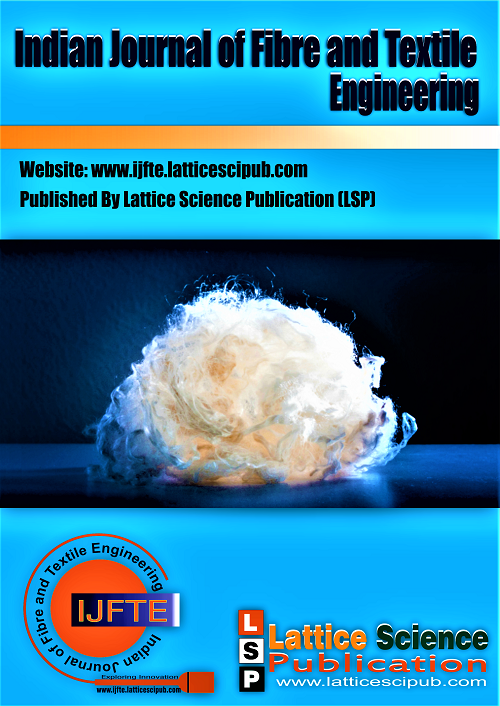Variations in the Application of Mordant of Dye Extracted from Coconut Husk on Cotton Fabric
Main Article Content
Abstract
Mordants are substances that help to bind the dye to the fabric to improving the colour fastness and durability of the dye. Dye was extracted using soxhlet extraction method, the percentage yield of the dye was also determined. Three different modant were used in the dyeing process, namely vinegar, table salt and baking soda. Colourimeter was used to collect information on assessment of colours of the extracted dye from coconut husk. The result obtained shows the % yield of extract to be 40%, which is significantly high, this is an indication that coconut waste is rich colour pigment. The delta value (ΔE) of light fastness of the dye extract on cotton fabric with no modant was higher than the (ΔE) modanted fabric. The modanted, vinegar has the highest (ΔE) with 69.2nm over baking soda 68.2nm, while table salt give the lowest (ΔE) with 61.5nm. The wash fastness quality characteristic also indicate that table salt used as modant has the highest e (ΔE) to be 66.6nm, over vinegar with 52.3nm, while baking soda has a (ΔE) of 51.9nm.
Downloads
Article Details

This work is licensed under a Creative Commons Attribution-NonCommercial-NoDerivatives 4.0 International License.
How to Cite
References
Ashis Kumar Samantaa & Priti Agarwal (2009). Application of natural dyes on textiles. Indian Journal of Fibre & Textile Research Vol. 34, pp. 384-399. DOI: https://nopr.niscpr.res.in/bitstream/123456789/6886/1/IJFTR%2034(4)%20384-399.pdf
Albert.F. Hill, (1951). Economic Botany, 2nd Edition (Mcgraw-hill publications in the botanical sciences, p. 225). DOI: https://www.scirp.org/reference/referencespapers?referenceid=2715063
Rahman M.L., and Haque, M.Z., Alam, M.M (2007). Bangladesh J. Sci. Ind. Res., p. 217-222. DOI: https://doi.org/10.9790/5736-0264547
Chilukoti., G. R., Venkatesh, B., Chavhan, Md. V., & Kumar, M. S. J. (2020). Colour Strength and Washing Fastness Properties of Cotton Fabric Dyed With Kasunda Flower Extract. In International Journal of Recent Technology and Engineering (IJRTE) (Vol. 8, Issue 5, pp. 2019–2022). DOI: https://doi.org/10.35940/ijrte.e5038.018520
Tan, I. A. W., Ahmad, A. L., & Hameed, D. B. (2008). Preparation of activated carbon from coconut husk: Optimization study on removal of 2, 4, 6-trichlorophenol using response surface methodology. Journal of Hazardous Materials. 153(1-2), 709-717. DOI: https://doi.org/10.1016/J.JHAZMAT.2007.09.014, Corpus ID: 12753978
Rodiah, M. H., Nur-Asma-Fhadhila, Z., Kawasaki, N., Noor-Asiah, H., & Aziah, M. Y. (2018). Antioxidant Activity of Natural Pigment from Husk of Coconut. Pertanika Journal of Tropical Agriculture Science. 41(1), 441-452. https://www.cabidigitallibrary.org/doi/pdf/10.5555/20183190983
Imo C., Ezaonu, C. S., Imo, N. G., & Anigbo, C.J. (2018). Proximate, Mineral and Phytochemical Composition of Cocos nucifera Nut. Asian Journal of Biochemistry. 13, 9-14. DOI: https://doi.org/10.3923/ajb.2018.9.14
Israel., A. U., Ogali, R. E., Akaranta, O., & Obot, I. B. (2011). Extraction and characterization of coconut (Cocos nucifera L.) coir dust. Songklanakarin Journal of Science and Technology. 33(6), 717- 724. https://pure.kfupm.edu.sa/en/publications/extraction-and-characterization-of-coconut-cocos-nucifera-l-coir-
Murugan R. and Parimelazhangan T. (2022). Comparative evaluation of different extraction methods for antioxidants and anti-inflammatory. J. Chem. Soc. Nig. Vol. 47. No.3. pp 625-640. DOI: http://dx.doi.org/10.1016/j.jksus.2013.09.006
Mahangade R.R., Varadarajan P.V., Verma J.K., Bosco H. (2009). New dyeing techque for enhancing colour strength and fastness properties of cotton fabric dyed with natural dye. Indian J. fabric and textile research. 34(3): 279-282. DOI: https://nopr.niscpr.res.in/bitstream/123456789/6080/1/IJFTR%2034(3)%20279-282.pdf
Charu swani, Sangita S. and Gupta V.B (2012). A study on green dyeing of cotton with ethanolic extract of Sesbania aculeate. Universal J. environmental research and technology. Vol. 2. Iss. 2:38-47. https://www.environmentaljournal.org/2-2/ujert-2-2-4.pdf
Osabohien, E. (2014). Extraction and application of dyestuffs from the leaves of guinea corn and onion skin, International Journal of Biological and Chemical Sciences, 8(2) 811. DOI: https://doi.org/10.4314/ijbcs.v8i2.36
Soun, B., Saini, Dr. H. K., & Brar, Dr. K. K. (2023). Study on Properties of Sisal-Cotton Union Fabrics Developed in Handloom and Power-Loom for Textile Application. In Indian Journal of Fibre and Textile Engineering (Vol. 3, Issue 1, pp. 1–4). DOI: https://doi.org/10.54105/ijfte.a2405.053123
Kumar K, R., & Chinnammal S, K. (2019). Influence of Fabric Parameterso Wicking Behaviour of Polyester/Lycra Knitted Fabrics. In International Journal of Innovative Technology and Exploring Engineering (Vol. 9, Issue 1, pp. 3864–3867). DOI: https://doi.org/10.35940/ijitee.a4939.119119
Venkatesh, B., Chavhan, Md. V., Ch., G., & Kumar, M. S. J. (2019). Kinetics of Reactive Dyed Pretreated Cotton Fabrics With and without using Salt. In International Journal of Recent Technology and Engineering (IJRTE) (Vol. 8, Issue 4, pp. 9723–9726). DOI: https://doi.org/10.35940/ijrte.d9191.118419
Patxullaev, S. U., Isaeva, D. H., Shumqorova, Sh. P., Yodgorova, X. I., & Orazbayeva, R. I. (2020). Effect of Secondary Raw Material on the Change of Single Extensive Elongation of Non Woven Fabrics. In International Journal of Engineering and Advanced Technology (Vol. 9, Issue 5, pp. 822–824). DOI: https://doi.org/10.35940/ijeat.e9499.069520
Prateek, P., Srivastava, S., Kumari, P., Kumar, C., & Murari, Dr. K. (2020). Influence of Coconut Fiber and Shell on Concrete. In International Journal of Innovative Science and Modern Engineering (Vol. 6, Issue 8, pp. 7–14). DOI: https://doi.org/10.35940/ijisme.h1250.076820





